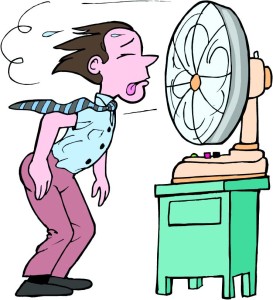Try to Minimize Solar Gain
In regions which experience relatively hot summers, the sales of air-conditioning units are rapidly increasing as well. A team of researchers from the National Oceanic and Atmospheric Administration and the United Nations estimate that the new cooling units entering the market could be responsible for up to 27% of all global warming by 2050.
I remember a time not long ago, when air conditioners in Delhi (India) were a luxury. Besides, many people adopted innovative strategies at passive solar cooling such as using thicker brick bat coba (for water and thermal insulation) on the roofs, having central courtyards with ventilators in rooms to naturally cool the houses. In fact, if one enters such a house today, one can experience the cooling effect without any artificial means. However, with the kind of construction now-a days, air conditioning is all but a necessity.
Recently however, there are concerns that the gases they run on are contributing to climate change.
Although modern air-conditioning units run on relatively sustainable gases* they still have an impact, although not on the o-zone layer. According to scientists, they “contribute to global warming thousands of times more than carbon dioxide”.
These new gases, called HCFCs, are not as damaging to the o-zone as the ones previously used, but they are being used in such amounts that scientists at the National Oceanic and Atmospheric Administration are concerned about the rising levels, especially in the developing world, where they have doubled in the past two decades to record highs.
One of the HCFC coolant called 410a is deemed “environmentally friendly” because it doesn’t damage the o-zone. However, its warming effect is 2,100 times that of carbon dioxide
“There is precious little time to do something, to act.” , according to Stephen O. Anderson, the co-chairman of the treaty’s technical and economic advisory panel.
Currently, there simply isn’t a readily available commercial ozone-friendly alternative to air-conditioners that have a substantial warming effect on the planet.
Till the time such a solution is made available, I cannot but help recommend the use of Architectural elements commonly found in Asia. I am reminded of an office I visited in Shilparamam, Hyderabad, which had a thatched roof surrounded by greenery and foliage. The structure had large open windows and despite the presence of heat contributing equipment such as computers, laptops and printers, I was relatively comfortable sitting under a fan in peak summer.
While it may not be completely practical to go back 50-60 years in construction technology, it would be certainly worthwhile to adapt such solutions, thereby reducing running costs and increasing the energy efficiency of buildings. Certain principle in Vastu Shastra, encourage the architect and the inhabitant to respect the elements of air, water, fire and earth, both in our immediate surroundings as well as that of the environment during design and construction. It views the creation of habitats, more as a symbiotic link between humans and the environment, rather than rigid objects which upset the balance of nature.
To learn more about how you can feel more connected to the space you inhabit through Vastu, you are welcome to get an appointment through this contact link.
Till then, focus on purchasing energy star appliances, installing energy star glazing and using construction techniques which minimize the requirement to maintain comfortable ambient temperatures. These methods not only help contribute to the environment but may also provide large savings on your energy bills.
*(the Montreal Protocol was created in order regulate and control the use of hazardous gases such as CFC coolants which caused massive damage to the o-zone layer leading them to be eliminated from general usage)
(Information credit : Are Air Conditioning Units A Climate Change Catch-22?) by Timon Singh)
(Image credit: http://www.theworkingwardrobe.com/wp-content/uploads/2013/07/air-conditioning.jpg)

